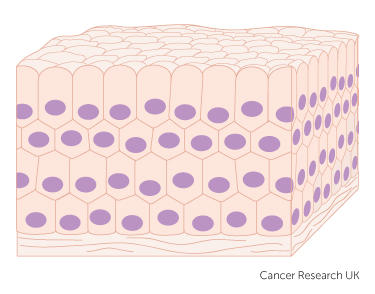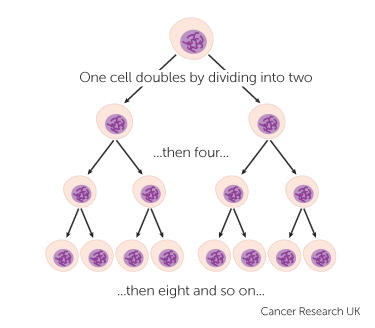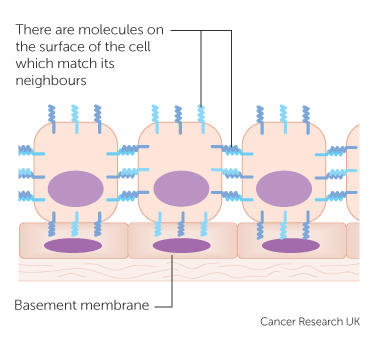How do normal cells and tissues grow?
This page tells you about how normal cells and tissues grow. You can read information about
Cells and tissues
Our bodies are made up of about a hundred million million (100,000,000,000,000) tiny cells. You can only see them under a microscope.
Cells group themselves together to make up the tissues and organs of our bodies. They are a bit like building blocks. The diagram below shows what cells look like when they are grouped together.
Different types of body cells make up the different types of body tissues. For example, there are bone cells in bone and breast cells in the breast.
There are more than 200 different types of cells in the body.
Read about the different types of cells and cancer.
How body tissues grow
Body tissues grow by increasing the number of cells. Cells in many tissues in the body divide and grow very quickly until we become adults.
When we are adults many cells mature and become specialised for their particular job in the body. So they don't make copies of themselves (reproduce) so often. But some cells, such as skin cells or blood cells are dividing all the time.
When cells become damaged or die the body makes new cells to replace them. This process is called cell division. So, a cell doubles by dividing into two. Two cells become four and so on. The diagram below shows cells dividing.
It seems that human cells can reproduce up to 50 or 60 times at most. Then they usually die.
Stem cells
Stem cells provide a pool of dividing cells that the body uses to restock damaged or old cells. Stem cells are a kind of ‘starter cell’. They have the potential to develop into different cell types in the body.
When a stem cell multiplies, the resulting cells may remain as stem cells. But under the right conditions, they become a type of cell with a more specialised function. For example a muscle cell,  or brain cell.
or brain cell.
Stem cells occur in the body in various places and stages during our lifetime. When we are an embryo,developing in our mother's womb stem cells give rise to all the different tissues and organs of the body.
In adults each type of stem cell is usually only able to develop into a few specific types of cell. For example, adult stem cells in the bone marrow, known as haematopoietic stem cells, usually only give rise to different types of blood cell.
Cancer stem cells
Scientists now believe that stem cells might play a role in the development of cancer. They think that some tumours develop from faulty stem cells. This has led to the idea of cancer stem cells, which scientists have now identified in a range of cancer types. The types include bowel, breast and prostate cancer as well as leukaemia.
Researchers are looking at whether some treatments could target cancer stem cells.
How cells grow and divide
When cells divide and grow they do this very precisely so that the new cells are exactly the same as the old ones.
Each cell makes copies of all its genes. Then each cell splits into 2 with one set of genes in each new cell. During the process, there are lots of checks to make sure that everything has copied correctly. But sometimes mistakes happen, which can lead to cancer.
Find out about genes and cancer with the information about how cancer starts
This 1 minute video shows how healthy cells divide.
View a transcript for the video about how healthy cells divide.
After dividing, the new cells rest for a while and then they may divide again if the body needs them. The cells carry on doing this until they have made enough cells.
The cell cycle
To divide, the cell goes through a process called the cell cycle. There are four main stages or phases.
- Gap 1 or G1 phase, where the cell grows in size, and checks that everything is OK for it to divide.
- Synthesis or the S phase, where the cell copies its DNA.
- Gap 2 or G2 phase, where the cells check that all its DNA has been correctly copied.
- Mitosis or M phase, where the cell finally divides in two.
The diagram below shows mitosis or M phase.
During mitosis, the cell shares the copied DNA equally between the 2 new cells. This means that the cell separates all the copied chromosomes into 2 full sets. One at each end of the cell that is splitting in two.
The other material that makes up the cell also splits in two. The result is two identical daughter cells.
How cells stop growing
Normal growth and healing is well ordered and precise. So, for example the cells know when:
- there are enough new cells to heal a cut, or
- a structure such as a finger is fully grown
Cells send chemical messages to each other so that they stop growing and dividing when growth or healing is complete. The diagram below shows this happening.
How cells stay in the right place
Cells in the body have a natural ability to stick together in the right place. This is so that the tissues and structures of the body form in the right way. This is called cell adhesion or 'stickiness'.
Molecules on the surface of the cell match those on its neighbours. It is a bit like having a postcode. The code makes it very difficult for the cell to move to the wrong place. But if the cell does find itself in a place where its postcode is different from its neighbours, it dies.
How cells die
When cells become damaged or worn out, they self destruct. This is called apoptosis. It helps to protect us from developing cancer. Cells can also undergo apoptosis if they have broken away from their proper place in the body.
Scientists are doing a lot of work on apoptosis. If they can understand what makes a cell self destruct, they might be able to use this to develop cancer treatments in the future.
How cancer cells and normal cells are different
Cancer cells are different from normal cells in a number of very important ways.







